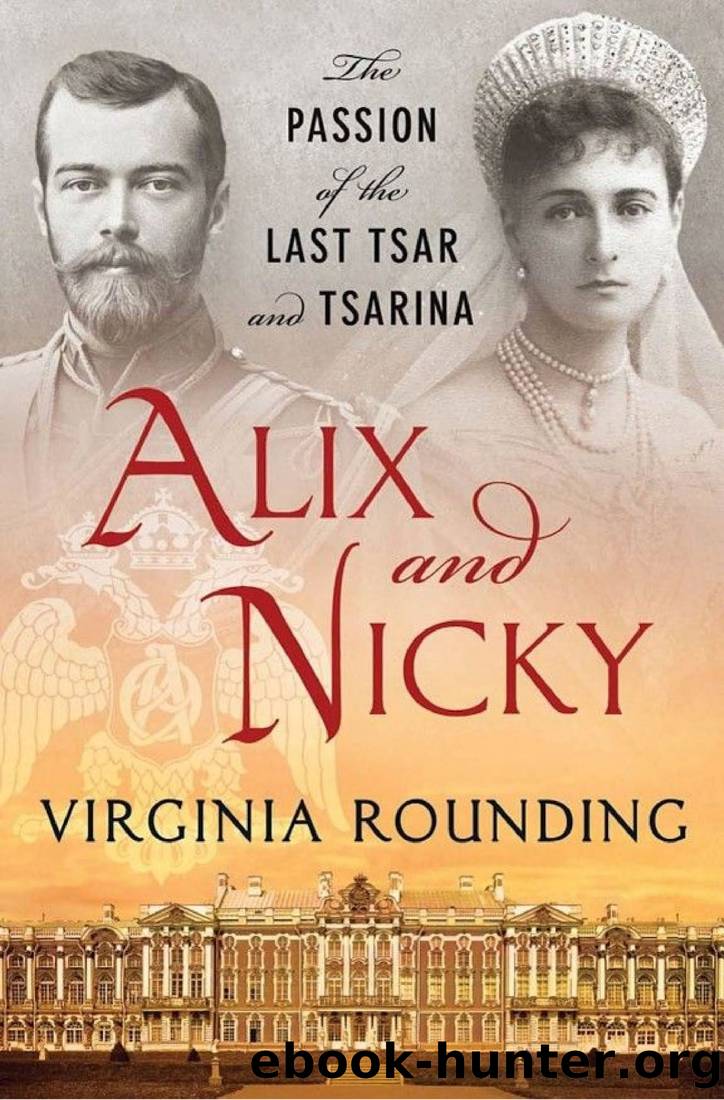Alix and Nicky: The Passion of the Last Tsar and Tsarina by Virginia Rounding

Author:Virginia Rounding [Rounding, Virginia]
Language: eng
Format: epub
Tags: Autobiography, Biography, History, Non-Fiction, Royalty, Russia & the Former Soviet Union
ISBN: 9781429940900
Google: hv_etSixIBwC
Amazon: B00A1A282C
Publisher: St. Martin's Press
Published: 2012-01-17T00:00:00+00:00
CHAPTER EIGHT
Grigory the Wonder-Worker
1912
Simple-lifers, utopian socialists, spiritualists, occultists, theosophists, quietists, pacifists, futurists, cubists, zealots of all sorts in their approach to life and art, later to be relentlessly classified into their respective religious, political, aesthetic or psychological categories, were then thought of by the unenlightened as scarcely distinguishable one from another: a collection of visionaries who hoped to build a New Heaven and a New Earth through the agency of their particular crackpot activities, sinister or comic, according to the way you looked at such things.
—Anthony Powell, The Kindly Ones—on the “unsorted ideas” prevalent throughout Europe in the decade leading up to the First World War
ON JANUARY 6, 1912, the Emperor authorized his uncle Grand Duke Pavel, who had been living abroad since his marriage to Olga Pistohlkors, to return to Russia. Pavel received back his grade of general aide-de-camp and his title of regimental chief, while his wife was authorized to take the name and style of Countess of Hohenfelsen. This was also the day on which Pavel’s son, Grand Duke Dmitry Pavlovich, who attained his majority that year, swore his oath of fealty to the Tsar and the Fatherland.
On January 14, Nicky and Alix visited the Academy of Arts in St. Petersburg to see an exhibition of ancient Russian icons and traditional craftwork, such as embroideries. This was part of the second All-Russian Congress of Artists, opened under the aegis of Grand Duchess Maria Pavlovna (the elder, widow of Grand Duke Vladimir), the president of the Academy of Arts. It covered art education, aesthetics, museology, folk art, conservation, and some aspects of the avant-garde, and included academicians as well as members of the World of Art movement. Its aim was to give a full survey of the attainments of Russian art at this vibrant period, which later came to be known as the “Silver Age.”
Around the turn of the year Bishop Hermogen of Saratov and the monk Iliodor had both definitively fallen out with Rasputin. They did not like the fact that their creature, like Frankenstein’s monster, had gone beyond their control, was moving in more powerful circles than theirs, and in fact no longer needed them or was prepared to operate in their interest. Hermogen, who had recently been appointed to the Synod in an attempt to “tame” him (he was another of extreme right-wing views), had demanded to see Rasputin and had berated him, in Iliodor’s presence, for his dissolute lifestyle and interference in the imperial household and had attempted to insist he return to his native village of Pokrovskoe and stay there. It is even possible that the two clerics had set upon Rasputin and physically attacked him. He managed to escape, but from now on he and the other two dubious characters were sworn enemies. Hermogen requested to see the Emperor, wanting to put his side of the story and denounce Grigory, but he was too late, Grigory having got there first. Hermogen was dismissed from the Synod, and exiled to a remote monastery in the province of Minsk.
Download
This site does not store any files on its server. We only index and link to content provided by other sites. Please contact the content providers to delete copyright contents if any and email us, we'll remove relevant links or contents immediately.
| Africa | Asia |
| Canadian | Europe |
| Holocaust | Latin America |
| Middle East | United States |
Fanny Burney by Claire Harman(25784)
Empire of the Sikhs by Patwant Singh(22172)
Out of India by Michael Foss(16312)
Leonardo da Vinci by Walter Isaacson(11903)
Small Great Things by Jodi Picoult(6095)
The Six Wives Of Henry VIII (WOMEN IN HISTORY) by Fraser Antonia(4790)
The Wind in My Hair by Masih Alinejad(4424)
The Lonely City by Olivia Laing(4120)
The Crown by Robert Lacey(4105)
A Higher Loyalty: Truth, Lies, and Leadership by James Comey(4032)
The Iron Duke by The Iron Duke(3639)
Millionaire: The Philanderer, Gambler, and Duelist Who Invented Modern Finance by Janet Gleeson(3569)
Sticky Fingers by Joe Hagan(3454)
Alive: The Story of the Andes Survivors by Piers Paul Read(3310)
Papillon (English) by Henri Charrière(3269)
Joan of Arc by Mary Gordon(3258)
Stalin by Stephen Kotkin(3086)
Aleister Crowley: The Biography by Tobias Churton(3019)
Ants Among Elephants by Sujatha Gidla(2924)
